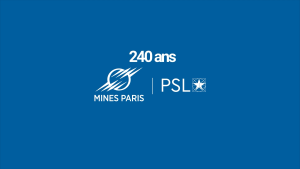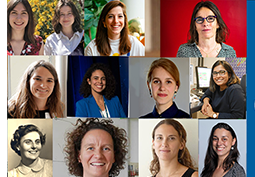



 Lecture
Lecture
Bio-based aerogels: new eco-friendly porous materials for thermal insulation and controlled release
Problèmes multi-physiques en élastoplasticité utilisant des champs locaux hétérogènes
| Spécialité | Mécanique |
| Ecole doctorale | ISMME - Ingénierie des Systèmes, Matériaux, Mécanique, Énergétique |
| Directeur de thèse | OVALLE-RODAS Cristian |
| Co-directeur | BOUVARD Jean-Luc |
| Unité de recherche | Centre des Matériaux |
| Contact | |
| Date de validité | 30/04/2024 |
| Site Web | https://www.mat.minesparis.psl.eu/formation/doctorat/propositions-de-sujets-de-these/ |
| Mots-clés | Model-free, champ local, corrélation d'images numériques (DIC), auto-échauffement, polymères semi-cristallins Model-free, local field, Digital Image Correlation (DIC), heat build-up, semi-crystalline polymers |
| Résumé | Dans ce sujet de thèse, nous proposons d'utiliser un paradigme connu sous le nom de modélisation pilotée par les données, consistant à formuler des calculs directement à partir de données expérimentales sur les matériaux et de contraintes essentielles et de lois de conservation pertinentes, en contournant complètement l'étape de modélisation empirique des matériaux de la simulation conventionnelle. Les contraintes essentielles et les lois de conservation telles que la compatibilité et l'équilibre restent inchangées, de même que tous les schémas numériques utilisés pour leur discrétisation : les éléments finis, les intégrateurs temporels, etc. Ces lois de conservation confèrent une structure mathématique aux calculs, et cette structure mathématique se retrouve dans le paradigme actuel axé sur les données. Cependant, dans la modélisation pilotée par les données, les points de données expérimentales sur les matériaux sont utilisés directement dans les calculs plutôt qu'un modèle empirique. De cette manière, l'empirisme, l'erreur et l'incertitude de la modélisation des matériaux sont entièrement éliminés et il n'y a pas de perte d'informations expérimentales. In this work, we propose using a paradigm known as data-driven simulation, consisting of formulating calculations directly from experimental material data and pertinent essential constraints and conservation laws, bypassing the empirical material modelling step of conventional computing altogether. Essential constraints and conservation laws such as compatibility and equilibrium remain unchanged, as do all the numerical schemes used in their discretization, such as finite elements, time-integrators, etc. Such conservation laws confer mathematical structure to the calculations, and this mathematical structure carries over to the present data-driven paradigm. However, in data-driven simulation the experimental material-data points are used directly in calculations rather than an empirical material model. In this manner, material modelling empiricism, error and uncertainty are eliminated entirely and no loss of experimental information is incurred.
|
| Contexte | Engineering materials are increasingly used in industrial applications under different strain rates, temperatures and loading conditions. To ensure in-service robustness and to predict the durability of components, identifying reliable and consistent models is of prime importance. Besides, macroscopic mechanical behaviour is commonly characterised by the stress-strain curve obtained from uniaxial tests. This identification method – empirical modelling and identification linked with data from uniaxial tests – induces some limitations.
|
| Encadrement | Directeur de thèse: Cristian OVALLE-RODAS
|
| Profil candidat | Ingénieur et/ou Master recherche - Bon niveau de culture générale et scientifique. Bon niveau de pratique du français et de l'anglais (niveau B2 ou équivalent minimum). Bonnes capacités d'analyse, de synthèse, d'innovation et de communication. Qualités d'adaptabilité et de créativité. Capacités pédagogiques. Motivation pour l'activité de recherche. Projet professionnel cohérent.
Engineer and / or Master of Science - Good level of general and scientific culture. Good level of knowledge of French (B2 level in french is required) and English. (B2 level in english is required) Good analytical, synthesis, innovation and communication skills. Qualities of adaptability and creativity. Teaching skills. Motivation for research activity. Coherent professional project.
|
| Résultat attendu | • Experimental data at two scales:
|
| Objectif | • to propose a new and different simulation framework in which the experimental material-data points are used directly in calculations rather than an empirical material model;
|
| Références | [1] T. Kirchdoerfer and M. Ortiz. Comput. Methods Appl. Mech. Eng., 326:622–641, 2017.
|
| Type financement | Concours pour un contrat doctoral |
| Document PDF |
Retour à la liste des propositions

Ecole
240 ans de recherche et de formation
Vidéo : 240ans de recherche…
> En savoir +
Recherche
Prix Jean Mandel 2023 mécanique des matériaux
Le prix Jean Mandel décerné tous les…
> En savoir +

Formation
Samuel Forest, élu membre de l’Académie des…
Samuel Forest lors de sa réception à…
> En savoir +

Formation
Mines Paris plébiscitée par ses étudiantes
Mines Paris - PSL, une école qui répond…
> En savoir +

Formation
Femmes de science
Chercheuses confirmées, doctorantes, élèves ou alumni,…
> En savoir +

Formation
Quelle école d’ingénieurs a le…
Mines Paris - PSL au Top 5 du classement LinkedIn 2023…
> En savoir +
